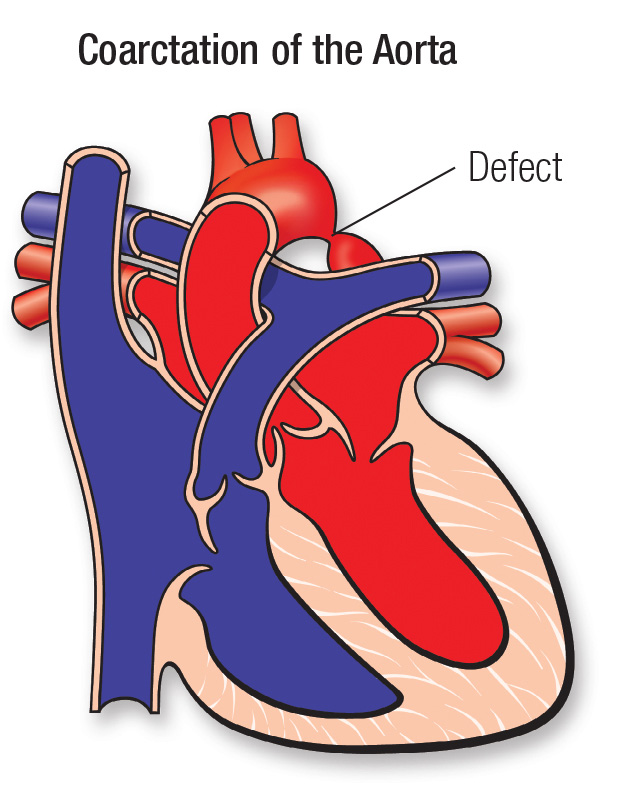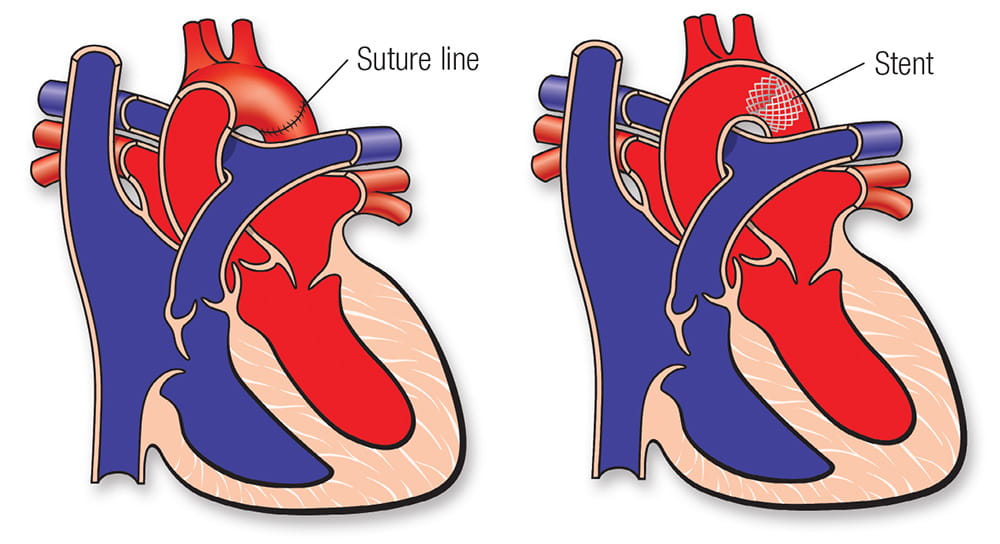Coarctation of the Aorta (CoA)

What is it?
In this condition the aorta (the main artery that carries blood from the heart to the body) is narrowed or constricted.
This narrowing affects blood flow where the arteries branch out to carry blood along separate vessels to the upper and lower parts of the body. CoA can cause high blood pressure or heart damage.
More information for parents of children with CoA
What causes it?
In most children, the cause isn't known. Some children can have other heart defects along with coarctation.
How does it affect the heart?
Coarctation obstructs blood flow from the heart to the lower part of the body. Blood pressure increases above the constriction. The blood pressure is much higher than normal in the left pumping chamber (left ventricle) and the heart must work harder to pump blood through the constriction in the aorta. This can cause thickening (hypertrophy) and damage to the overworked heart muscle.
How does the coarctation affect my child?
Usually no symptoms exist at birth, but they can develop as early as the first week after birth. A baby may develop congestive heart failure or high blood pressure.
If the obstruction is mild, the heart won't be very overworked and symptoms may not occur. In some children and adolescents, coarctation is discovered only after high blood pressure is found.
What can be done about the coarctation?
The coarctation obstruction can be relieved using surgery or catheterization.
Surgery is often used to repair coarctation. A surgeon doesn’t have to open the heart to repair the defect. It can be fixed in several ways. One way is for the surgeon to remove the narrowed segment of the aorta. Another option is to sew a patch over the narrowed section using part of the blood vessel to the arm or a graft of synthetic material.
Cardiac catheter balloon dilation and stent placement is also used, more commonly in older patients and in patients with recurrent coarctation after surgery. In this case the balloon may stretch the area of narrowing while the stent provides stiff support to prevent the vessel from returning to the smaller size.

An infant with a severe coarctation should have a procedure to relieve the obstruction. This may relieve heart failure in infancy and prevent problems later, such as developing high blood pressure as an adult because of the coarctation.
What activities can my child do?
If the coarctation has been repaired, there is no important leftover obstruction or high blood pressure, your child may not need any special precautions regarding physical activity, and may be able to participate in normal activities without increased risk.
Some children with obstruction, hypertension, heart muscle abnormalities or other heart defects may have to limit their physical activity. Check with your child's pediatric cardiologist about this.
What will my child need in the future?
The outlook after surgery is favorable, but long-term follow-up by a pediatric cardiologist is needed. Rarely, coarctation of the aorta may recur. Then another procedure to relieve the obstruction may be needed. Also, blood pressure may stay high even when the aorta's narrowing has been repaired.
What about preventing endocarditis?
Children with coarctation of the aorta may risk developing endocarditis. Your child's cardiologist may recommend that your child receive antibiotics before certain dental procedures for a period of time after coarctation repair. See the section on Endocarditis for more information.
Congenital Heart Defect ID sheet
More information for adults with CoA
Coarctation of the aorta is a narrowing of the aorta between the upper body branches and the lower body branches. It's typically in an isolated location just after the "arch" of the aorta. The blockage can increase blood pressure in your arms and head, yet reduce pressure in your legs. Abnormalities of the aortic valve (usually bicuspid; see Aortic Stenosis and Insufficiency section) may also be present. At times, the narrowing of the aorta is so severe that there's essentially no connection between the upper and lower portions of the aorta ("Interrupted aortic arch").
What causes it?
The area where coarctation of the aorta occurs is usually in the same spot where the ductus arteriosus closes. Sometimes, during normal closure of the ductus in the first week of life, tissue can build up and cause a narrowing.
How does coarctation affect the heart?
Coarctation of the aorta can cause high blood pressure in the heart. This can cause the muscle of the heart's main pumping chamber (left ventricle) to become thick. Eventually, the function of the heart muscle could deteriorate if the condition isn't treated.
How does coarctation affect me?
Many people don't know there's a problem. High blood pressure in the arms is typical. When present in a young person, it should prompt investigation for coarctation. Sometimes adults may have headaches, renal problems frequent miscarriages, or lack of energy when using their legs. However, such symptoms are common in the general population and are usually due to other causes.
If my coarctation was repaired in childhood, what can I expect?
Most patients repaired before 1985 underwent surgery. The surgeon had several options depending on the circumstances such as the length and location of the coarctation. Younger adults may have had a repair in the catheterization laboratory (referred to as interventional or therapeutic catheterization (PDF)) where the narrowing was expanded by a balloon inserted through a small hole in your leg. Often a metal stent was left in place to hold the area open. This may also be an option if further narrowing occurs in an adult.

What if coarctation is still present? Should it be repaired in adulthood?
Yes, coarctation can be repaired at any age and should be addressed as soon as it's diagnosed depending on the severity of the coarct. Adolescents and adults with coarctation can often be treated by cardiac catheterization.
Problems you may have
High blood pressure is the most common problem adults have. It can be present even if your coarctation was successfully fixed. High blood pressure is more common if the coarctation was repaired after five years old. Patients treated in childhood are at risk for redeveloping the coarctation (recoarctation) and may require catheterization. Most patients with recoarctation of the aorta after initial repair usually don't have symptoms, which makes regular assessment by a physician all the more important. Many times the area will renarrow to a degree, or other portions of the aorta may enlarge (aneurysms) with potential to rupture. These may need to be addressed with further intervention. Patients may develop coronary artery disease, leaving them vulnerable to heart attacks. There may even be an increased risk of having an aneurysmal blood vessel in the head.
Ongoing Care
What will I need in the future?
Everyone with a known coarctation of the aorta should be seen annually by a cardiologist with expertise in caring for adults with congenital heart disease even if the coarctation has been successfully repaired. Blood pressure should be measured in the arms and legs. Medicines are often advised, typically beta blockers (atenolol or metoprolol) to control the blood pressure. Regular imaging of the aorta should be done by echocardiography or MRI. CT scanning can also show the area well, but isn't advised for repeated routine checks because it involves radiation. You should also consult a cardiologist with expertise in caring for adults with congenital heart disease if you're undergoing any type of non-heart surgery or invasive procedure.
Activity
Most activities are likely safe, and encouraged. Heavy isometric exercise, such as power weightlifting, may be a particular concern especially in patients who have enlargement of the aorta since it raises the blood pressure quickly. See the section on Physical Activity and Exercise for more information.
Endocarditis Prevention
Although infection of a coarctation can occur, it isn't likely. More commonly, patients may develop infection of a coexisting abnormal aortic valve. All patients are advised to practice good oral care.
Pregnancy
Women with repaired coarctation can carry a pregnancy with low risk. The exception is if there's a residual (leftover) narrowing of the aorta or if there's high blood pressure or enlarged areas of the aorta. It's best to plan ahead and have a thorough check-up including an imaging study of the aorta to detect these problems before becoming pregnant, and control the problems before conception. See the section on Pregnancy for more information.
Will I need more surgery?
The need for surgery or catheterization depends mostly on the level of pressure in your arms and legs when you're resting and, under some circumstances, during exercise. If your arm and leg blood pressures are normal and equal, you probably won't need more intervention. If you blood pressure is elevated in your arms and more than 20 mmHg higher than in your legs, it is likely further intervention will be needed. When problems occur, more and more institutions use catheters rather than surgery, which is much easier for the patient.







